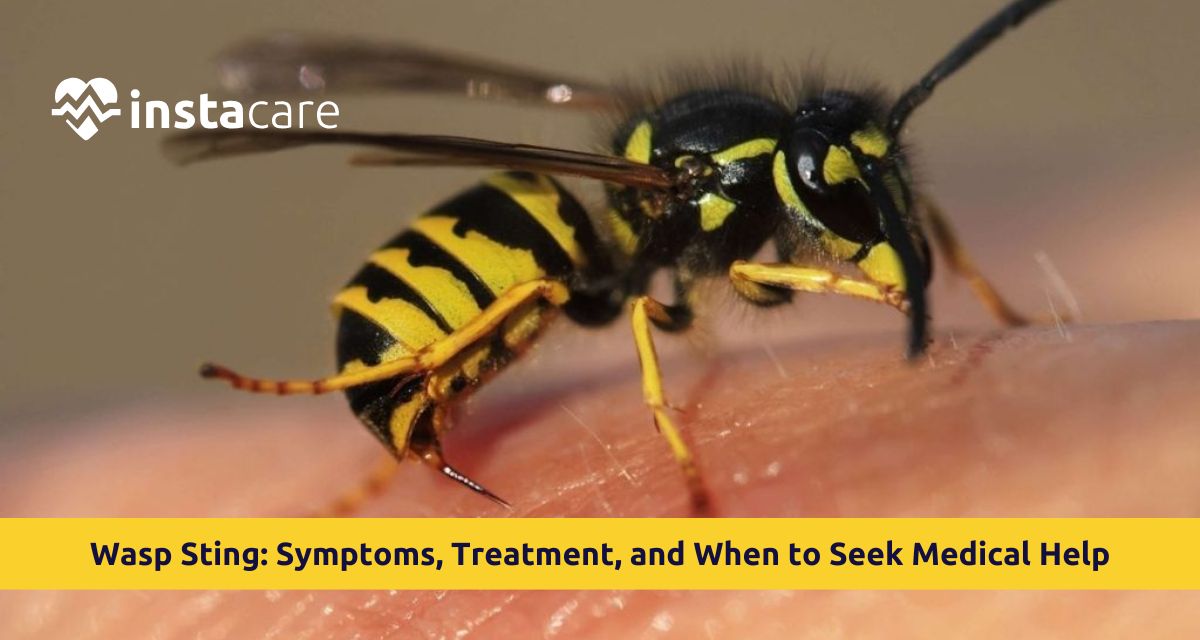Wasps are common insects found almost everywhere, especially during warm weather. Wasps are distinct from bees since they can sting repeatedly and are therefore more dangerous in some situations. Understanding proper wasp sting treatment and wasp sting first aid goes a great way towards your recovery.
This is a guide that will allow you to understand all that you ought to know about wasp stings, from how you can identify the symptoms to when to see a doctor for a wasp sting.
What is Wasp Sting?
A wasp sting takes place when a wasp stings your skin with its stinger to deliver venom. Wasps sting for defense or defense of nests when threatened with their stingers. Unlike honey bees which die if they sting for the first time, wasps can sting many times because their stingers do not get lodged in your skin.
There are several different species of wasps, such as yellow jackets, hornets, and paper wasps. These will all have the same effects when they sting. They carry venom in their stings that includes chemicals to produce pain, swelling, and other reactions where they have stung. Wasps are nastier than bee stings and sting again. They enjoy sweet foods and beverages, so you will usually see them flying around in the vicinity of food, trash, and sweet beverages.
What Happens When a Wasp Stings?
When a wasp stings you, several things happen virtually immediately:
The Stinging Process:
- Venom Injection: The wasp inserts its stinger into your body and injects venom. Venom consists of proteins and chemicals that cause immediate pain and swelling.
- Immune Response: Your immune system recognizes the venom as foreign and produces an immune response to fight it. Redness, swelling, and heat start developing where you were stung.
- Pain Signals: The venom activates the pain receptors in your skin, creating the sharp, burning sensation you feel immediately after you've been stung.
- Inflammation: The capillaries of the area where the wasp stung swell up, causing redness and wasp sting swelling. This is the body reacting to provide healing cells to the injured tissue.
These are the normal reactions for the majority of individuals. There are individuals who become allergic to a wasp sting, which is far more dangerous and will require wasp sting emergency care.
Common Symptoms of a Wasp Sting
Wasp sting symptoms vary from individual to individual, but the majority of people react as below:
Normal Local Reactions:
- Burning pain at the place of the sting that is severe
- Redness of skin
- Wasp sting swelling which may last longer than 24-48 hours
- Heat at the place of the sting
- Itching that may take a couple of days
Large Local Reactions:
- Swelling that propagates to locations other than the place of the sting
- Wasp sting rash a few hours after stinging
- Swelling getting bigger that takes 2-3 days
- Pain that lasts longer than normal
Wasp sting allergic reaction (Severe):
- Difficulty breathing or wheezing
- Swelling of lips, face, or throat
- Racing pulse
- Dizziness or fainting
- Nausea or vomiting
- General wasp sting rash or hives
- Severe anxiety or feeling of doom
Call wasp sting emergency care right away if you see any wasp sting allergic reaction.
First Aid and Home Treatment
Knowing proper wasp sting first aid can help relieve pain and prevent complications:
Immediate Action:
- Get Away to Safety: Back away from the spot to remain out of reach from any more stings
- Search for Stinger: Wasps hardly ever leave their stinger behind, but check them too
- Clean the Site: Clean the site of the sting with soap and water to prevent wasp sting infection
Wasp sting home remedies and treatment are:
- Cold Compress: Apply ice in a cloth for 10-15 minutes to relieve swelling and numb the pain. It is among the best methods for wasp sting pain relief.
- Elevation: If the sting is on an arm or leg, raise the arm or leg above heart level to minimize swelling.
- Pain Relief: Take over-the-counter drugs like ibuprofen or acetaminophen for pain and swelling.
Topical Treatments:
- Calamine lotion will soothe itching
- Hydrocortisone cream will reduce inflammation
- Aloe vera gel provides cooling comfort
Natural Wasp sting home remedies:
- Baking soda paste (water incorporated with it) may nullify venom
- Apple cider vinegar can reduce pain and swelling
- Honey possesses antibacterial effect
Avoid: Do not scratch the sting region, as this can lead to wasp sting infection and exaggerating the symptoms.
Medical Treatment for Wasp Sting
At times you may need medical wasp sting treatment along with home treatment:
Antihistamine Treatment:
Wasp sting antihistamine medications like Benadryl will also reduce allergic reaction and itching. They are most useful when taken soon after being stung.
Prescription Medications:
- Stronger antihistamines for severe local reaction
- Steroids to be applied locally or by mouth for generalized swelling
- Antibiotics if the wasp sting infection develops
Signs of Wasp sting infection:
- Increasing redness and spreading
- Red streaks from the site of the sting
- Yellow discharge or pus
- Fever
- Worse pain than on the first day
Call a health care provider right away if you have any of the above signs of wasp sting infection.
When to Seek Emergency Help?
It's a lifesaver to know when to see a doctor for a wasp sting. Call wasp sting emergency care help right away if you have:
Severe Wasp Sting Allergic Reaction:
- Trouble breathing or feeling short of breath
- Swelling of the face, lips, tongue, or throat
- Weak or rapid pulse
- Dizziness or fainting
- Nausea or vomiting
- Wasp sting rash or hives on the entire body
- Severe anxiety
Other Emergency Situations:
- More than One Sting: If you have been stung many times (more than 10-15 stings), seek wasp sting emergency care even if you don't have allergic symptoms.
- Past Severe Reactions: If you have had a severe wasp sting allergic reaction in the past, seek medical care immediately.
- People at Risk: Individuals with heart disease, respiratory illnesses, or weakened immune systems should seek medical care earlier.
- Signs of Infection: If signs of wasp sting infection appear in the sting area after a day or two.
Don't wait if you're not sure - better to get help and not require it than to wait too long.
Prevention Tips for Wasp Sting
The best wasp sting treatment is prevention. Here are tips you can follow in order to avoid getting stung:
At Home:
- Seal trash cans tightly
- Discard food and drinks as soon as you eat outdoors
- Don't leave food outside for pets
- Check ground surrounding your house for wasp nests on a regular basis
- Seal holes and cracks where wasps will nest
When Outdoors:
- Don long pants and closed shoes around wasp-infested locations
- Don't wear floral or bright-print clothes
- Don't wear perfume or fragrant lotions
- Don't flail when a wasp is coming at you - don't swat at it
- Cover food and drinks at picnics and outdoor parties
If You Encounter Wasps:
- Back away slowly and calmly
- Don't make sudden movements
- If you are stung by more than one wasp, take cover and shield your head
- Never disturb a nest of wasps
For Those with a Documented Allergy:
- Always carry an epinephrine auto-injector (EpiPen)
- Medical alert jewelry should be worn
- Inform family and friends of your allergy
- Meet with an allergist regarding venom immunotherapy
Conclusion
Educating yourself on wasp sting symptoms and proper treatment can help you deal with these common accidents in a safe way. Temporary pain and wasp sting swelling are usually caused by most wasp stings, but you should be cautious against symptoms of deadly wasp sting allergic reaction that must be treated by medical professionals without delay. Remember that how long does a wasp sting last varies with each person.
Most normal reactions get better in a few days, and large local reactions take at least one week and sometimes longer to fully heal. The largest variation in wasp sting vs bee sting is that wasps can sting repeatedly and have no stinger attachment. Effective wasp sting first aid starts with seeking a safe place, washing the wound, and using cold therapy for wasp sting pain relief.
Wasp sting home remedies are good, but don't wait to visit a doctor if you're concerned about your symptoms. The secret is having the ability to know when to see a doctor for a wasp sting. If you experience any evidence of a severe wasp sting allergic reaction, stinging repeatedly, or wasp sting infection evidence, go directly to the hospital. Prevention is always the best, so avoid wasps and nests whenever you can.

